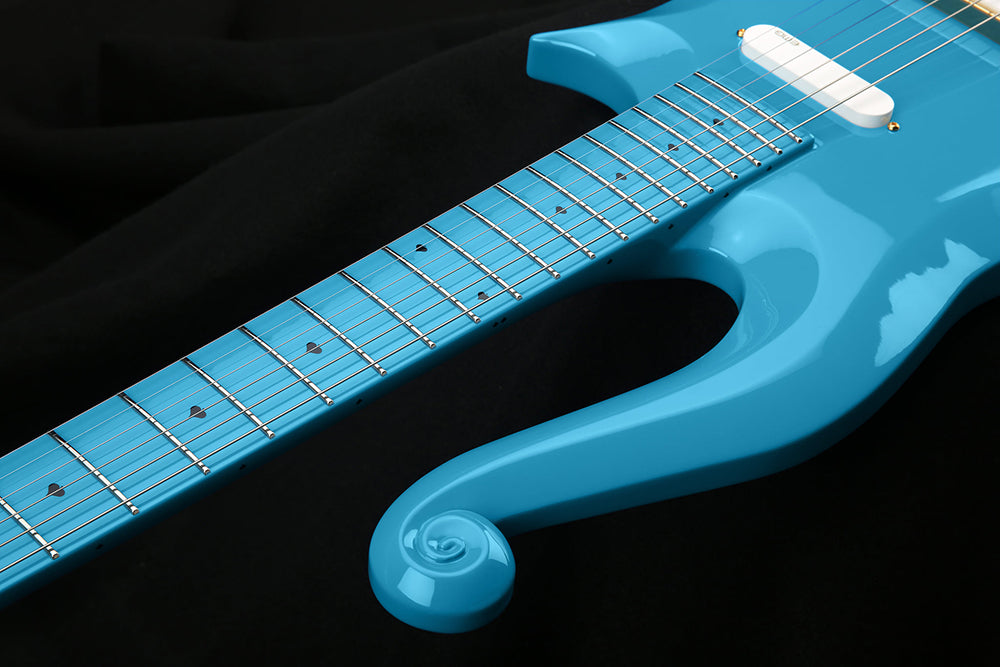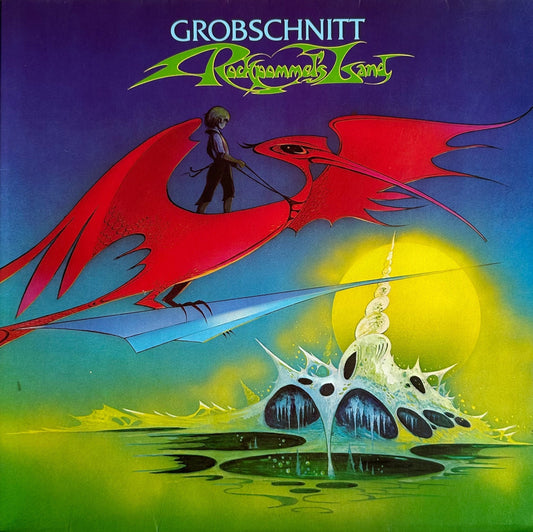Dave Rusan is the proprietor of Rusan Guitarworks of Bloomington, Minnesota. He built the iconic “Cloud” guitar for Prince and is also an audiophile. His clients include the Rolling Stones, Sheryl Crow, Brian Setzer, Dire Straits, Genesis, Iron Maiden, and many others. Part One of this interview appeared in Issue 184, and picks up where we left off here.
Frank Doris: Do you have a high-end system at home? Are you an audiophile?
Dave Rusan: Oh, yes, yes I am. Have you ever heard of PS Audio?
FD: (laughing hysterically) I think I have! [Truthfully, I had no idea Dave had PS Audio gear up until this point.]
DR: (laughs) I have a giant system. I’ve got about 60 grand in my stereo, which, in the world of high-end, [some people] probably spend that [just] on cables, but it's an awful lot more than most people would ever spend on a stereo.
I’ve got two [PS Audio] BHK 300 power amps, a BHK Signature preamp, and a couple of the PowerPlants. My speakers are Magnepan 20.7s. And I have two REL G1 Mark II subwoofers.

Dave Rusan.
FD: Must be a nice-sounding system. Now people are gonna think that the reason I did this interview is because you have PS Audio gear!
DR: I did a lot of research [in deciding what to buy]. I sold some valuable guitars to get that gear.
I thought, I'm not only gonna get good stuff. I'm gonna try and get stuff that is considered an especially good value for the money, like the Magnepans. They’re considered kind of a bargain compared to some other stuff. It is a fantastic [speaker] system. I still am amazed every time I play it. The walls [of the listening room] disappear.
FD: I've always liked their speakers and I'm a really big fan of their ribbon tweeters.
DR: Well, the ribbons, the way they reproduce flutes, or the scrape of the bow against the string on a violin…I have the subwoofers crossed over real low, to where it's pretty seamless. There's nothing I've ever bought that I've enjoyed as much as this stereo system.
FD: A lot of audiophiles seem to spend their whole lives never getting there, or listening to the same five recordings over and over again, and tweaking and endlessly upgrading or this or that. I'm guilty of that sometimes, where I'm reviewing the hardware or changes in the sound rather than just sitting back and enjoying the music.
DR: I suppose if somebody carted in some of those expensive Wilson Audio speakers, I'd go, holy sh*t, look what I've been missing? [On the other hand], I have a system worth about $1,000 with a little receiver and ELAC bookshelf speakers and that can be fine. It's enjoyable enough, but you don't get all the [musical] details. I don't wanna be a snob, but…
FD: It’s a shame that most people have literally never heard a really, really good audio system.
DR: I would say that the big deal is way the hidden details come out [in the music], rather than just the tonality or the “bigness.” My big system seems to elicit a lot more emotion in me. You know?
FD: Oh, yeah. That's what it's all about.
The thing is, it’s all connected. I think most audiophiles got into it, not so much because they're sound freaks, but because they wanted to hear their favorite music sound good. I know that's why I got into it. The first time I heard a friend’s father’s high-end system I was flabbergasted.
 A Cloud guitar in its early stages.
A Cloud guitar in its early stages.
DR: I loved the idea of stereo equipment as much as the music. I just loved them both. As a kid, my mom and dad had a Zenith console with a radio and record player. I used to stick my head in the back and there was that musty smell of the wood and the electronics. Yeah. To my parents, music was for background listening.
One day they took me to a big store called Schmitt Music, where they had everything. I heard a KLH system, and I remember hearing more high frequencies coming out of a speaker. (laughs). I realized this was actually high-fidelity. After that I got the Large Advent speakers. I augmented them with electrostatic tweeters made by JansZen. I went right to the factory in Minneapolis. I would get the Allied Radio and Radio Shack catalogs, go to the local store and bug the salesmen.
Remember Julian Hirsch? [He was one of the most well-known audio reviewers of the time in the 1960s through the 1990s, and wrote for Stereo Review – Ed.]
FD: Sure. Harry Pearson of The Absolute Sound would bust Hirsch’s chops in print for relying on measurements rather than doing listening tests. But then I met Hirsch at one of Harry’s parties and asked, “what are you doing here? Don’t you guys hate each other?” “Oh no, no, no, no, we’re good friends!” he answered. Hirsch was always really nice to me.
DR: I met some rock stars who were like that. One day Greg Lake came into the store. I expected him to be kind of full-on pompous, maybe a little arrogant. Maybe due to [Emerson, Lake & Palmer’s] music, And he comes in, and he was just a big, goofy, happy guy. Like he'd buy you a pint at the pub, you know, he was, he was nothing like that. Ever hear of Shawn Phillips? He was a sensitive kind of poet guy. But he’d talk like Ted Nugent, and he'd tell you a dirty joke.
 A batch of Cloud guitars in progress.
A batch of Cloud guitars in progress.
 Hand-finishing the cutaway.
Hand-finishing the cutaway.

Sign o' the times: Prince symbol fretboard inlays.
FD: We're all pretty wiped out by the loss of Jeff Beck. Did you ever meet him?
DR: No. I saw him a few times. I saw him in his beginner band, the Yardbirds. When I was in London, he never came into the store. I was told he could be kind of a prickly guy to work with. (laughs)
But he just kept getting better. He evolved. When he [went to using] a [Fender] Stratocaster, he kept moving ahead.
I have a friend, Takumi Suetsugu. He worked for Prince for 10 years, and he did a show with Jeff Beck. He said Beck could pick up any guitar and play through any amp. It didn't sound exactly the same, but he sounded like himself, you know? He had such control. There's one song on Jeff Beck's Guitar Shop where he hits a harmonic and plays an entire melody just with the whammy bar.

Dave Rusan in 1984. He made these guitars for Wendy Melvoin (of the Revolution, Prince's band at the time) and Prince. Melvoin's guitar has silk flowers embedded in it. Prince's guitar is one of the first that Rusan made for him.
FD: What other players do you like?
DR: Well, I'm a big fan of Gary Moore. He backed up Greg Lake when Lake was doing a solo career. So, he played all the King Crimson and Emerson Lake & Palmer stuff, and he must have worked his ass off to get that ready for that tour.
He was a nice guy. Very moody though. It came out when he played. He’d play in the store really loud. And it wasn't just loud; he had an edge to him. It was almost kind of scary being around him when he played.
He'd been terribly knifed up in an altercation in Ireland. His face was all cut up. He looked terrible up-close. I wonder if that changed him? When he played it all come out.
FD: Did you ever get to meet Steve Hackett (of Genesis, and later solo)? He's one of my favorites.
DR: No, I worked on his Shergold guitar, though. A Shergold double neck. A British guitar with controls that looked like something off a 1960s transistor radio.
I did work for Mikey Craig, the bass player from Culture Club, who is still with the band, They still have all the original guys except for Jon Moss, the drummer, who left in 2021.
I did work for Randy Rhoads [guitarist for Ozzy Osbourne and Quiet Riot]. I got to know him a bit. Did work for Mike Oldfield, iron Maiden, Dire Straits, Peter Tosh…he came in with this guitar that looked like a gun.
I did some work for Dick Taylor…he was in the Pretty Things. He started The Stones with Mick Jagger, and then quit to go back to school. I remember thinking, boy, that was the one time when that wasn't a good idea!

A vision of a white Cloud.

Dave's signature on the back of the headstock.
We’d get a lot of guys who are on tour and were in a panic; something broke and they needed it fixed before the show. But in the 1970s the industry to support them was not all that well-developed. There weren't a lot of huge music stores and there weren't a lot of good guitar repair people. The place where I worked wasn’t well-equipped with lutherie tools when I first started working there. I remember the bass player from Culture Club had bought a new graphite neck and wanted to put it on his Fender bass. And they didn't have a drill press in the shop! They tried to install it using a hand drill!
FD: Can you still get the really nice wood, like you could get in the Fifties and Sixties?
DR: No, you can't. They used to have the old-growth wood. It grew in the forest and it grew slow. ‘Cause it had a tough life. I didn't get a lot of sun or [nourishment]. So the rings were close together and [the wood] became stable. Now they don't have that, and the newer guitars are much more prone to being damaged by lack of humidity. On the other hand, there’s now a torrifying [wood-drying] process that helps. It hardens up the cell structure, and makes the wood a lot like an old guitar, more stable and also more resonant.
FD: How about guitars made from composite materials?
DR: Like the RainSong. It sounds different, but I don't know if it's inferior. Maybe you have to have different criteria [to judge them].
FD: On another note: the cheap guitars back in the 1960s and early 1970s were terrible. Today, inexpensive guitars are generally good.
DR: You can buy a Strat-type copy for $150, $200 bucks. As opposed to – last year I had an old Harmony archtop guitar in for repair and the whole thing was made out of birch [a wood not normally used for guitar construction]. Even the fingerboard, which had fake wood grain painted on.
I had a Stella guitar as a rental when I started playing. It was so terrible. I remember trying for the F chord, and it was impossible. I would watch guitar players on TV and ask my mom, “how come when people are on TV, they can smile when the play guitar, because aren’t they in pain?” People rhapsodize about the golden age of vintage guitars, but many of the cheaper ones weren’t very good (or maybe terrible).
On the other hand, I’ve had [modern] $200 guitars in here that are just unbelievable for the money. And the things that were good about the past are [always] being rediscovered. Some [builders], like Pre-War Guitars Co., are making fantastic reproductions of older instruments. It's a wonderful time.
 A finished Cloud guitar, ready to go to its eager customer.
A finished Cloud guitar, ready to go to its eager customer.
Rusan Guitarworks
8301 Wyoming Ave. S.
Bloomington, MN 55438
daverusan@gmail.com
Facebook:
Rusan Guitarworks
Rusan Guitarworks Guitars
Instagram:
rusanoriginal
All photos of the Cloud guitars courtesy of Bob Cole Photography.



